B2B (business-to-business) sales are increasingly shifting online, fueling the growth of B2B eCommerce businesses and alternative sales channels including B2B marketplaces.
A B2B marketplace makes procurement easier for buyers, allowing them to search and compare multiple vendors during their sourcing efforts. A B2B marketplace is also a valuable sales tool for B2B businesses, helping bring added exposure and simplified selling to help accelerate growth.
This guide is designed for B2B organizations looking to utilize marketplaces in their sales strategy, with details on:
- What are B2B eCommerce marketplaces and what business models they serve
- Examples of B2B marketplaces
- The benefits and challenges associated with a B2B marketplace strategy
- Tips to help you put together a successful B2B eCommerce marketplace strategy of your own
What Is a B2B eCommerce Marketplace?
The B2B eCommerce Market was valued at USD 19.34 Trillion in 2024, and is expected to reach USD 47.54 Trillion by 2030, rising at a CAGR of 16.17%.
A B2B eCommerce marketplace is a sales channel that brings together a variety of business sellers and a high volume of business buyers. B2B marketplaces can be either:
- Horizontal, selling products or services to a wide variety of businesses (e.g. office supplies using Amazon Business), or
- Vertical, selling niche or specialized products to one specific industry or sector (e.g. DeHaat facilitating the sale of various agricultural products to the agricultural sector)
Furthermore, B2B marketplaces can operate in:
- Physical goods, products, and inputs
- Services (e.g. freight, trading, hiring professionals)
- Rentals (e.g. equipment, office space)
B2B business models using a marketplace sales channel:
In a direct B2B model, a marketplace sales channel helps facilitate the sale of a product or service to an end buyer who is a business.
The marketplace may be third-party to reach a wider range of buyers (e.g. Amazon, Freightos) or B2B-owned (enterprise marketplace) to sell their products or service and/or take a commission on all sales.
| B2B business | →Third-party marketplace | →End business buyers |
| B2B business Other suppliers | →B2B-owned marketplace (enterprise marketplace) | →End business buyers |
B2B+ business models using a marketplace sales channel:
In multi-step B2B business models such as B2B2B (business-to-business-to-business) or B2B2C (business-to-business-to-consumer), the B2B marketplace sales channel might appear in one or more places in the sales chain using intermediaries, including distributors, wholesalers, resellers, retailers, or brokers.
| B2B wholesaler | →B2B intermediary | →B2B marketplace | →End business buyers | |
| B2B wholesaler | →B2B marketplace | →B2B intermediary | →End buyers (business or consumer) | |
| B2B wholesaler | →B2B marketplace | →B2B intermediary | →B2B or B2C marketplace | →End buyers (business or consumer) |
B2B vs B2C marketplaces
Although B2C and B2B marketplaces each facilitate sales to an end buyer, they do have differences buying the buyer (consumer vs businesses), with B2B marketplaces needing to support the differentiated features of B2B eCommerce including support for B2B pricing models and complex catalogs.
| B2B | B2C | |
|---|---|---|
| Buyer | Can include many stakeholders | Single individual |
| Order volume | Can be high | Low |
| Pricing model | Differentiated pricing | Standard price |
| Sales process | Can be long, multi-step (approvals) | Immediate |
| Payment options | Credit accounts, check, payment upon delivery | Credit card, BNPL (buy now, pay later plans) |
| Inclusion | Strict approval process to sell | Low bar for joining as a seller |
| Delivery | May include multi-location, as fast as possible or restricted to a specific day / time, transparent shipping information | Single location, as fast as possible, transparent shipping information |
Let’s have a look at why your B2B business may want to consider a B2B eCommerce Marketplace strategy.
Why Are B2B eCommerce Marketplaces Important for Your Business?
Gartner estimates that by 2025, 80% of B2B buying will shift online, with 75% of B2B buyers indicating a preference for a rep-free or self-serve sales experience. These trends are fueling the need for B2B sellers to explore new ways to meet buyer expectations for streamlined, personalized, seamless procurement using online channels — one of the top B2B eCommerce challenges is meeting these expectations.
B2B marketplaces offer B2B businesses (manufacturers/producers/service-providers or downstream intermediaries) a chance to reach a wide base of buyers in their target audience, with the potential to leverage platform capabilities to manage payment and fulfillment logistics. The B2B marketplace may be a new channel for your business, but it’s also a channel that helps you meet your buyers where they are.
59% of B2B buyers conduct more than 25% of their purchases in marketplaces
Furthermore, B2B buyers are increasingly bringing consumer expectations to their B2B buying experience, looking to accelerate the procurement cycle, particularly the research stage of comparing products or services. For B2B buyers, marketplaces offer the chance to view a wider range of products or curated solutions, simplifying procurement decisions based on availability, price, feature, or delivery options. We will dive into benefits further in a later section of this document, but for now let’s explore some of the top third-party B2B marketplaces.
The Top B2B Marketplaces You Should Know
As noted earlier, third-party B2B marketplaces can be either horizontal or vertical, with Digital Commerce 360 estimating that there will be more than 1,000 vertical marketplaces in as soon as two years. Despite this, horizontal marketplaces continue to dominate. Some of the most well-known marketplaces include:
1. Amazon Business
Amazon Business is the most significant B2B marketplace, connecting manufacturers or distributors to reach business customers on the comprehensive Amazon platform.
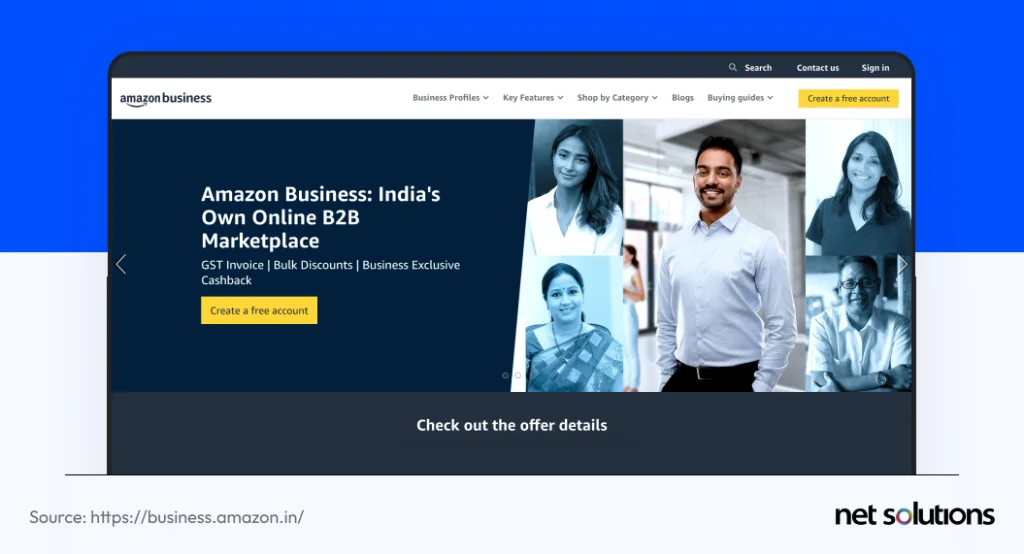
Amazon Business is already trusted by over 150,000 sellers, supporting $10 billion in annualized sales thanks to its similarity to the consumer Amazon platform: supporting the same selection, convenience, and price transparency buyers have come to expect, with elevated experiences needed for B2B purchasing.
Amazon Pros:
- Reaches 1+ million B2B buyers and integrates with 90+ procurement systems
- Buyers in the following markets: US, Canada, Spain, UK, France, Germany, Italy, India, Japan
- Streamlined operations, including shipping, fulfillment and even storage.*
- Qualified orders can take advantage of “Business Prime” services for fast two-day shipping.*
- Very easy to get started
- Support for business pricing, quantity discounts, requests for quotes, certifications to support sourcing / ESG goals
- Wide category support
*Note, fulfillment by Amazon is when Amazon assumes product storage, distribution and delivery and is necessary to Business Prime services.
Amazon Cons:
- High cost (flat fee per item or month + average of 8-15% referral fee)
- The size of the marketplace can place greater emphasis on price competition over other comparison features, diluting brand value
- Increased competition for market share
- Limited seller profile information to establish brand value
- Can be difficult to enter the market against competition with strong seller ranks (based on reviews, seller ratings, sales volume etc)
How Amazon compares to other marketplaces: Amazon is a leader, for the value it provides businesses and buyers, and should be a first consideration for most B2B sellers.
2. eBay Business Supply
eBay is most commonly associated with B2C sales of pre-owned goods, but it has a growing market share in refurbished as well as new and wholesale goods for B2B buyers. In fact, 79% of eBay goods are new and unused.
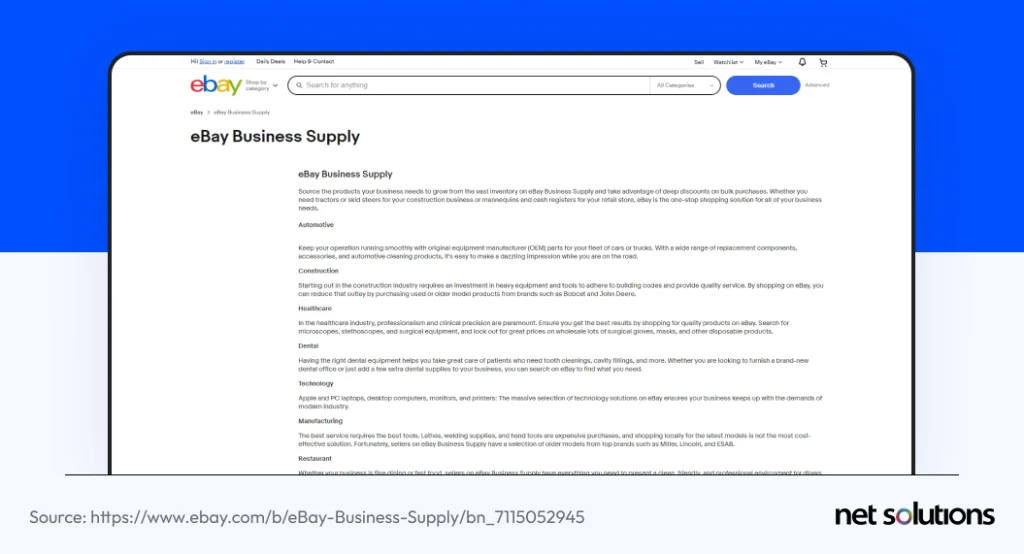
eBay Business Supply supports many categories of business and industrial products with access to a global buyer base.
eBay Pros:
- Offers flat rate freight and global shipping
- Offers financing options with Express
- Option for “Buy It Now” direct sale as well as auction pricing
- Over 138 million global buyers (B2C and B2B) in 190 countries
eBay Cons:
- Insertion fees are non-refundable, even if your product does not sell
- Costs are high, a combination of insertion fee and percentage of sale
- Insertion fees at $0.05 to $0.25, $20 per item for some business categories
- Final value fees at 12.35% on total amount of the sale up to $2,500 calculated per item and 2.35% on the portion of the sale over $2,500
- Perception of ‘used’ goods, even for new products
How eBay compares to other marketplaces: The only option for refurbished products, but for bulk sales, Amazon fees are probably lower.
3. Alibaba
Alibaba is a global marketplace for buyers looking for prices at low price, in large quantities, or for custom products, serving both consumer and business buyers.
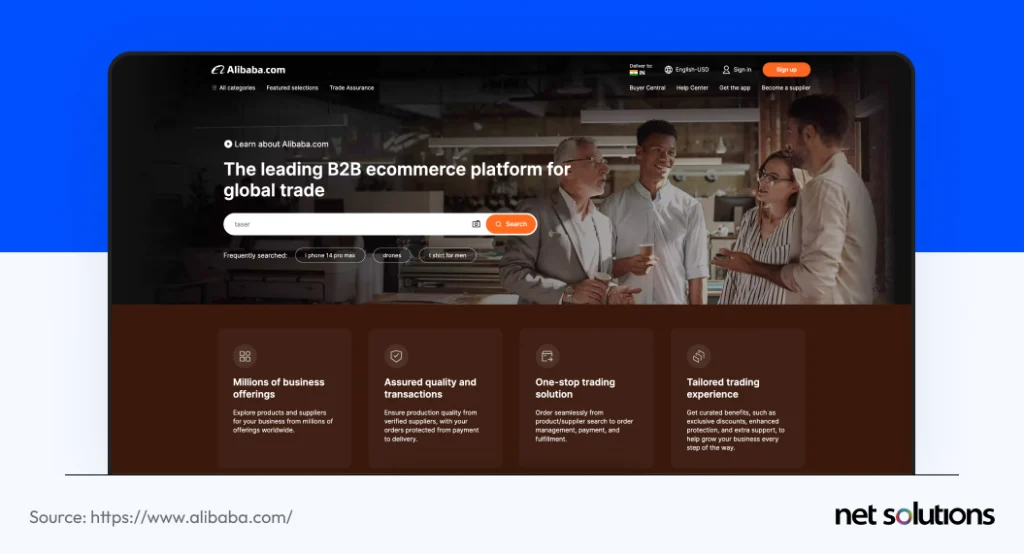
Alibaba hosts one of the largest B2B marketplaces,
Alibaba Pros:
- Global reach with 200+ countries (17 languages) and regions and 40M+ active buyers
- Serves over 5,900 product categories, so you can be granular in your categorization
- AI tools to manage your storefront and products, see buyer insights, and speed operations
- Supports on-platform advertising by keyword, paid search, display ads and more
- Advanced targeting, customization and pricing capabilities
- Supports direct communication between buyer and seller
- Supports logistics and shipping, including freight forwarding, customs clearance and fulfillment
- 0% sales commission – plans begin at $166/month to $1,866/month for Verified Supplier status.
Alibaba Cons:
- Competition is high against a marketplace in the millions and 200k+ suppliers
- International focus, not as well known in the North American audience, some fear of purchasing from a Chinese multinational
- Encourages negotiation and price focus, which you may not want to incorporate into every sale or be associated with
- Language barriers with buyers from international markets
How Alibaba compares to other marketplaces: Alibaba has a strong international presence and a flat fee, no sales commission, making it a strong option for wholesalers selling in bulk.
4. Zoro
Zoro is a marketplace that sells tools, parts, raw material, and business supplies (MRO inventory) to support businesses across industries.
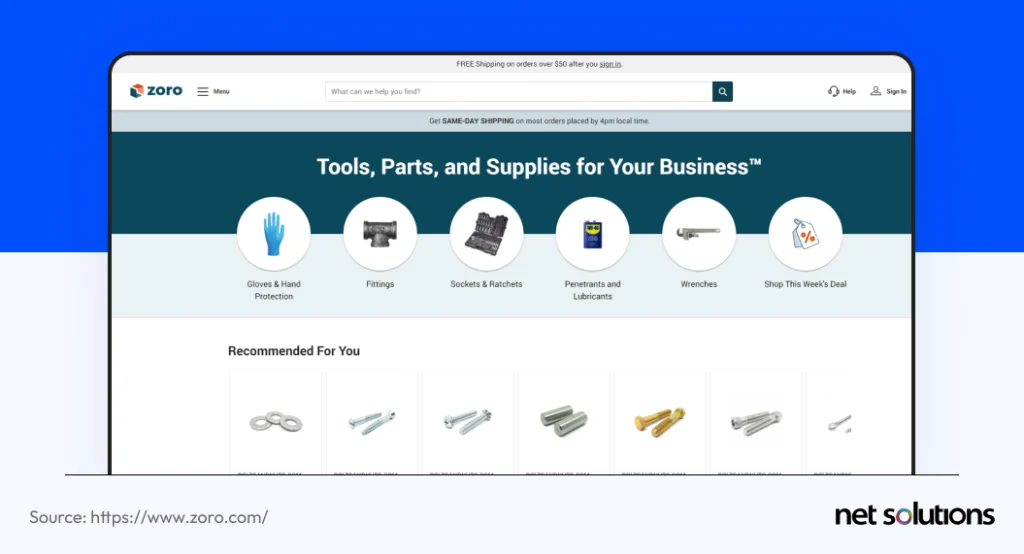
Zoro has seen accelerated growth, from $1 billion in sales in 2022 to $29.6 billion in 2024 and holds market dominant positions as top distributor for plumbing and top 3 for HVACR, Industrial supplies and building materials/construction. Zoro is a wholly owned subsidiary of Grainger
Zoro Pros:
- Offers very fast shipping, including the option for same-day shipping on many orders
- Offers a one-stop shop for many businesses, as not overly focused on one vertical
- Support for net 30 terms, which is appealing to some buyers
- Zoro owns the entire sales process
Zoro Cons:
- Strong focus on price, diluting brand value
- Distributors and manufacturers need to be able to meet the fast shipping guarantees
- Zoro sets its own margin (you sell to them, they market and sale at a price of their choice), which may undercut your other sales channels
How Zoro compares to other marketplaces: Zoro competes with Amazon and eBay for MRO supplies for small businesses and may be a more cost effective marketplace, since you set your own price.
5. Xometry
Xometry is a marketplace that connects enterprise buyers from across a variety of industries with suppliers of manufacturing services, offering “manufacturing on demand”.
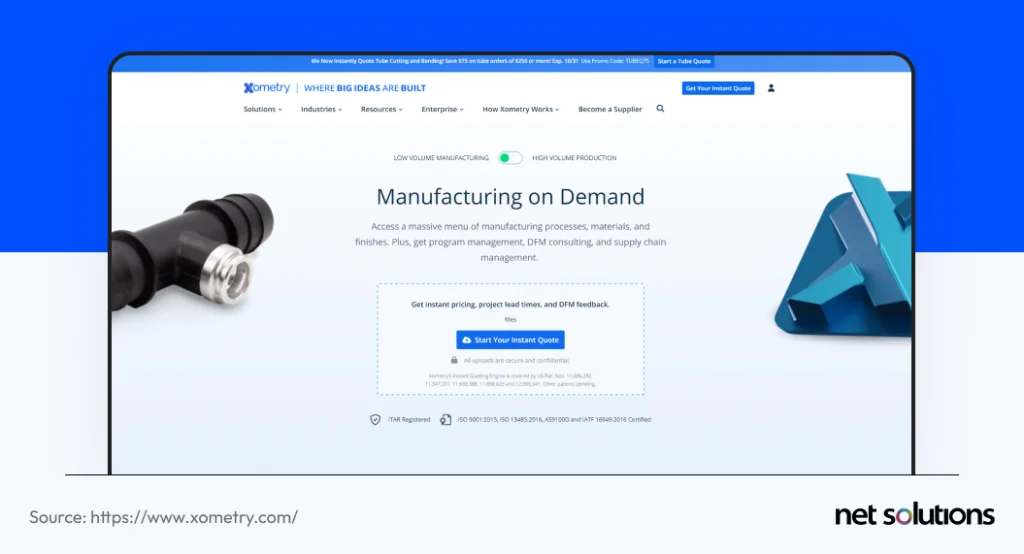
Xometry has grown its revenue 19% year-over-year to $133 million in Q2 2024, helping to digitize manufacturing and increase capacity within manufacturing to support more resilient supply chains.
Xometry Pros:
- Serves a wide variety of industries, from aerospace and defense, automotive, consumer products to design agencies, medical, robotics and education
- Leverages Google Cloud Vertex AI to analyze parts in real-time and match buyers with the right suppliers and with accurate pricing and lead times, eliminating long RFP processes
- International presence in China, Australia, Europe and North America
Xometry Cons:
- Organizations need strong cloud maturity to be able to participate in prototyping, production or other machining needs
- Communication is not direct between buyer and ‘seller’, causing delays
- Places focus on price, reducing brand integrity and reputation
How Xometry compares to other marketplaces: A marketplace that serves multiple verticals with niche services, likely to continue to dominate in this service area.
6. Custom enterprise marketplaces
Horizontal marketplaces are not always the right solution for selling your product or service. For niche products and services that serve a specific vertical or smaller segment, there’s a great opportunity to create vertical marketplaces. In some cases, you may be both a seller on the marketplace as well as the marketplace owner, taking a commission for each sale from other suppliers.
Job portals are one example of a service-based marketplace, listing jobs from a variety of businesses (buyers of talent) to a variety of job hunters (sellers of their talent). These job marketplaces offer access to a pool of talent, rather than posting jobs to a void of unknown talent in a standard job board. An example includes Fiverr, an online marketplace for freelance services.
Net Solutions worked with VOYlegal, a leading legal recruiting firm in the US, to create a curated recruiting system that was based on a core CRM, adding sophisticated features that gave organizations and recruiters sophisticated tools to seek job candidates based on narrow criteria. Read more here.
Now, let’s examine some of the reasons you may want to consider a B2B eCommerce marketplace strategy.
What Are the Benefits of B2B eCommerce Marketplaces?
The benefits of B2B eCommerce marketplaces align with the overall benefits of B2B eCommerce, helping you deliver an enhanced customer experience across channels and delivering greater scalability and growth.
“Organizations without a third-party marketplace strategy risk losing share to competitors that are proactively pursuing this rapidly growing digital sales channel.”
― Gartner
Let’s explore some of these benefits in detail:
1. Expanded reach and market access
Connect with a wider audience of customers for your product or service, both small companies and large multinationals. For example, Amazon Business boasts that its buyers include 55 of the Fortune 100 companies and 50% of the biggest US hospital systems. As a B2B seller or manufacturer, you are not limited to just one marketplace, but can instead leverage several marketplaces to increase your exposure and reach new global markets.
Can your B2B eCommerce platform manage marketplaces, ensuring stock and pricing levels adjust in real-time? Learn more in our B2B eCommerce platform comparison and B2B eCommerce platform cost comparison.
2. Cost-effective sales channel
Exposure to an entire new market or expanded buyer base is based on the cost of the marketplace participation (flat and/or per item fees), with the marketplace sharing in marketing costs to attract an expanding base of buyers.
3. Streamlined procurement and sales processes
Marketplaces offer fast, convenient comparison shopping from a wide selection of businesses with streamlined, transparent shipping options and the benefit of standard B2B capabilities for exclusive pricing, flexible payments, and approval workflows. By offering this experience to your buyers, you help meet them where they are. If you are the buyer purchasing from a manufacturer or wholesaler, then reselling, you also reap these benefits in your own purchasing.
4. Enhanced data and analytics capabilities
Most established B2B marketplaces will offer built-in metrics to help track your store and inventory performance and provide valuable insight into your buyer, preferences, and buying behavior. Depending on your goals, you’ll want to establish if the marketplace offers these insights or if you can integrate with third-party services to capture additional information.
Learn more about what kinds of B2B eCommerce metrics you should track.
5. Improved operational costs
B2B marketplaces often assist with operations in areas such as tax calculation, fulfillment, customs coordination, payment processing and more. In the case of Amazon for Business, this can even extend to product storage, reducing warehousing costs.
6. Trust
B2B marketplaces may vet their suppliers, introducing buyers to new suppliers that lack brand awareness and conveying a level of trust. Many marketplaces also have quality, payment and shipping guarantees.
Now let’s explore some of the challenges of working with B2B marketplaces.
What Are the Drawbacks of B2B eCommerce Marketplaces?
There can be challenges entering and operating a B2B eCommerce marketplace:
1. Intense competition and price wars
Marketplaces directly pitch suppliers against each other, by default presenting products based on price rather than brand value. In some cases, marketplaces facilitate price negotiations or auctions, placing even greater emphasis on price competition. Where competition is saturated, it can be difficult to break into a new category against high-volume sellers with high ratings and perceived trust.
2. Lack of control over brand experience
Marketplaces present information in a standard way, offering limited capabilities to establish or differentiate your brand. Further, brand experience moves beyond the page and extends to every interaction you have with the customer – since marketplaces may not allow interaction, this can significantly diminish your ability to control or improve the customer experience.
3. Fees and commissions
While you may save on operational and potentially even marketing costs, marketplaces can add significant costs to your bottom line in terms of monthly base costs and/or sales / listing / referral fees. Look carefully at fee structures per category before deciding on a marketplace strategy.
4. Potential for channel conflict
When you use a marketplace strategy, this might present a channel conflict if one channel offers prices or promotions at the expense of others. For example, if you agree to sell on Zoro, they set the price and assume the marketing, which could be in conflict with your other sales channels (own website, in-store). If customers note this discrepancy, it can damage trust and brand value.
5. Data ownership and privacy concerns
Marketplaces need to abide by the data security and privacy regulations of the markets in which they operate (sell to), so if you create a marketplace, you face significant hurdles to maintain privacy and support consumer rights to be forgotten.
6. No access to buyer information to close or nurture relationships
Privacy concerns typically restrict the collection of buyer data to the marketplace, not the business, increasing the loyalty to the marketplace (e.g. Amazon) instead of the brand.
However, in B2B sales, the focus is less on the first sale and more on nurturing the lifetime value of the customer. In order to close the sale in a long buying cycle, sales often reaches out to buyers with educational material, webinars, and offers of assistance. In a marketplace strategy, you do not have access to customer information to support sales or post-sales nurture materials, potentially reducing the lifetime value of each customer.
What Are the Common Challenges of Participating in B2B eCommerce Marketplaces?
While we’ve touched on some of the downsides of marketplaces, they still remain a strong eCommerce strategy for many B2B businesses. However, in setting up and operating your marketplace channel, you need to be aware of these common challenges:
1. Complex buyer needs and customization
B2B buying behavior is more complex and not always well supported on marketplaces, including the need for customized pricing, multi-step purchasing with approvals and authorizations, flexible payment terms or methods, and customer-specific catalogs. In the absence of direct contact with buyers, you may have limited capabilities to answer questions or customize your pitch.
2. Integration with existing systems
It is critical to establish your marketplace strategy with all the integrations you need to support and ensure data integrity across systems. There is a risk that product information on your marketplace is incomplete or out of date if the integration is not maintained. Existing systems you may wish to integrate include your enterprise resource planning software (ERP), your B2B eCommerce platform (as long as it supports marketplaces natively or with extensions), and fulfillment software, to name a few.
3. Maintaining product information accuracy
If you sell across channels but maintain data for each channel separately, either manually adjusting a master list or relying on independent data stores, you risk product information becoming out of date. Instead, look for marketplaces that integrate with your enterprise resource planning (ERP) software and/or sophisticated eCommerce platforms that sync product information across channels and also with your ERP.
4. Managing logistics and fulfillment
Depending on the marketplace you choose, either you or the marketplace will be responsible for fulfillment — and often at significant speed, meeting buyer expectations for marketplace purchases. If you are unable to accurately estimate shipping or provide a sub-par fulfillment experience, this could result in a return, a low product rating, or a negative review that lives with you on the platform indefinitely.
5. Adapting to marketplace policies and changes
Marketplaces are highly regulated, with an increasing number of policy changes as the legal requirements change across countries and regions or as the marketplace adapts to business conditions with new requirements for sellers (e.g. fulfillment speed). Failure to comply with marketplace policies may see you ejected from the marketplace.
What Are the Key Components of a Successful B2B eCommerce Marketplace Strategy?
For a successful marketplace, it is critical that you choose a marketplace that mirrors or reflects your business strategy. When creating your strategy for a new sales channel, you need both business and technical knowledge or the help of a strategic partner such as Net Solutions, who will help you to:
1. Understanding your market and audience
Know which geographic regions you want to sell to, which vertical(s), and your target buyer before selecting the marketplace(s) where you’d like to operate. Carefully evaluate each marketplace for saturation within your target market and if the marketplace supports the product categories, filtering or product information you need to highlight.
If you are a seller of a very high value product, skew more towards vertical niche marketplaces. If you are a seller of bulk, low-priced products that appeal to a wide base, a general horizontal marketplace will work. If you sell a product that often involves a lot of customer interaction with sales, or multiple stakeholders, you may wish to re-evaluate if a marketplace strategy is right for you.
2. Building a robust digital infrastructure
Don’t put the cart before the horse. It is critical to ensure your infrastructure can handle the requirements of working with one or more marketplaces, including keeping your product information in sync and meeting the fulfillment demands of your chosen marketplace. If you do not have a robust B2B eCommerce platform that supports marketplaces, check out our B2B eCommerce migration services.
3. Enhancing user experience
You want to choose a marketplace that provides the level of user experience you want to deliver to your users. Choose a marketplace that conveys trust, aligns with customer values (e.g. ESG or local procurement goals), offers 24/7 customer service, is transparent with shipping or pricing information, and is seamless everywhere users buy (laptop, mobile).
4. Leveraging data and analytics
Leverage your in-marketplace and external analytics (e.g. within your eCommerce platform) to understand your buyer behavior and optimize your channel strategy which could include changing product information, re-pricing, reconsidering product categories, or revising the overall marketplace strategy.
It’s Your Turn Now
Whether you are a B2B seller, manufacturer or merchant who is new to eCommerce and looking to set yourself up for long-term success, or you’re looking to unlock new levels of growth with B2B marketplaces, we can help.
Net Solutions offers comprehensive eCommerce development services to help you understand when and how to use marketplaces, when to leverage or create a vertical marketplace, and how to manage marketplaces as part of your overall eCommerce strategy (including choosing or migrating to a platform that supports marketplaces).
SHARE THIS POST
Table of Contents
Related Resources
- AI in B2B eCommerce: Everything You Need to Know
- Top 14 B2B eCommerce Benefits in 2025
- The B2B eCommerce Catalog: Everything You Need to Know
- The Biggest B2B eCommerce Challenges (And How to Address Them)
- The Ultimate Guide to B2B Fashion eCommerce: Strategies, Trends, and Solutions
- 18 Must-Have B2B eCommerce Features To Look For in 2025
- Headless B2B eCommerce - How to Redefine Your Business
- Top B2B eCommerce Metrics to Track for Success [2025]
- B2B Mobile eCommerce - A Comprehensive Guide
- Why Your Business Needs a B2B eCommerce Mobile App
- 11 Top B2B eCommerce Open Source Platforms for 2025 [With Real Reviews]
- B2B eCommerce Platform Costs: A Comprehensive Guide (2025)
- 12 Top B2B eCommerce Platforms for 2025 [With Real Reviews]
- B2B eCommerce Pricing Strategies: An In-Depth Guide
- Your In-Depth Guide to B2B eCommerce Replatforming
- Top 9 B2B eCommerce Trends to Watch in 2025
- B2B eCommerce UX: A Comprehensive Guide
- A Step-by-step Guide to B2B eCommerce Website Development
- 9 of the Best B2B eCommerce Website Examples in 2025


